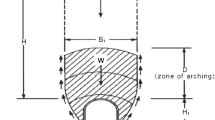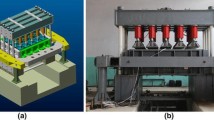Summary
The selection of rock bolting lengths and spacings for a mine roof or back is relatively straightforward when wedges of rock bound by discrete discontinuities require support, or when the immediate roof can be anchored into a recognizably stable layer or rock mass. When neither of these situations is present the choice of bolt lengths and spacings is more difficult.
In this paper a simplified conceptual model is presented which invokes the concept of an ellipticallyshaped zone of loosening above the opening, all, or a portion of which, may require support. The analysis includes the influence of opening span, height,in situ stress state, and rock mass quality as measured by the CSIR Rock Mass Classification.
Validation of the model was sought by analysing a number of case histories in the literature.
Similar content being viewed by others
References
Barton, N. and Bakhtar, K. (1983) Bolt design based on shear strength, inProceedings of the International Symposium on Rock Bolting, Abisko, Sweden, 237–48.
Barton, N., Lien, R. and Lunde, J. (1974). Engineering classification of rock masses for the design of tunnel supports.Rock Mechanics,6, 4, 189–236.
Bieniawski, Z.T. (ed) (1976) Rock mass classifications in rock engineering, inProceedings of the Symposium on Exploration for Rock Engineering, Vol. 1, A.A. Balkema, 76–106.
Bieniawski, Z.T. (1978) Determining rock mass deformability — experience from case histories.International Journal of Rock Mechanics and Mining Science,15, 5, 237–48.
Brown, E.T., Bray, J.W., Ladanyi, B. and Hoek, E. (1983) Ground response curves for rock tunnels.Journal of Geotechnical Engineering,109, 1, 15–39.
Coates, D.F. (1981)Rock Mechanics Principles, Energy, Mines and Resources, Canada, Monograph 874 (revised).
Cogan, J.P. (1951) The mechanics of rock failure,Quart. Colorado School of Mines, ‘An Introduction to the Design of Underground Openings for Defence’,46, 1, 83–125.
Heuze, F.E. and Goodman, R.E. (1973) Finite element and physical model studies of tunnel reinforcement in rock, inProceedings of the 15th U.S. Symposium on Rock Mechanics, South Dakota, 36–67.
Hibino, S., Motojima, J. and Kanagawa, T. (1983) Behaviour of rocks around large caverns during excavation, inProceedings of the International Congress on Rock Mechanics, Melbourne, Australia, Vol. D, 199–202.
Hoek, E. and Brown, E. (1980)Underground Rock Engineering, Institute of Mining and Metallurgy, London.
Kaiser, P. (1981) A new concept to evaluate tunnel performance — influence of excavation procedure, inProceedings of the 22nd U.S. Symposium on Rock Mechanics, Boston, 264–71.
Kvapil, R. (1965) Gravity flow of granular materials in hoppers and bins: Part, I, II,International Journal of Rock Mechanics and Mining Science,2, 35–41, 277–304.
Morrison, R.G.K. (1970)A Philosophy of Ground Control, Dept. of Mining and Metallurgical Engineering, McGill University, Montreal, Canada.
Papanastassopoulou-Tsatsanifou, E. (1983) Investigation of effect of rock bolts on stress distribution around underground excavations, inProceedings of the International Symposium of Rock Bolting, Abisko, Sweden, 55–63.
Peng, S.S. (1978)Coal Mine Ground Control, John Wiley & Sons, New York.
Protodyakanov, M.M. (1962) Methods of studying the strength of rock used in the USSR, inProceedings of the International Symposium on Mining Research (edited by G.B. Clark), Pergamon Press, London, 649–68.
Stimpson, B. (1983) The influence of rock bolt location on the reinforcement of horizontally bedded roofs by full column grouted bolts, inProceedings of the International Symposium on Rock Bolting, Abisko, Sweden, 195–204.
Stimpson, B. (1985)The Behaviour and Design of Roofs Supported by Non-Tensioned Resin Bolts, CANMET (DSS), 450 pp.
Stheeman, W.H. (1982) A practical solution to cable bolting problems at the Tsumeb Mine, inCIM Bull.75, 838, 65–77.
Szechy, K. (1966)The Art of Tunnelling, Akademiai Kiado, Budapest.
Terzaghi, K. (1946) Rock defects and loads on tunnel supports, inRock Tunnelling with Steel Supports (edited by R.V. Proctor and T.L. White).
Unal, E. (1983)Design Guidelines and Roof Control Standards for Coal Mine Roofs, PhD Thesis, Pennsylvania State University, USA.
Wagner, H. (1983) Protection of service excavations. InRock Mechanics in Mining Practice, Chapter 12, South African Institute of Mining and Metallurgy, Johannesburg.
Walton, G. and Taylor, R.K. (1977) Likely constraints on the stability of excavated slopes due to underground coal workings, inProceedings of the Conference on Rock Engineering, Newcastle upon Tyne, England, 329–49.
Author information
Authors and Affiliations
Rights and permissions
About this article
Cite this article
Stimpson, B. A simplified conceptual model for estimating roof bolting requirements. International Journal of Mining and Geological Engineering 7, 147–162 (1989). https://doi.org/10.1007/BF01554343
Received:
Issue Date:
DOI: https://doi.org/10.1007/BF01554343




